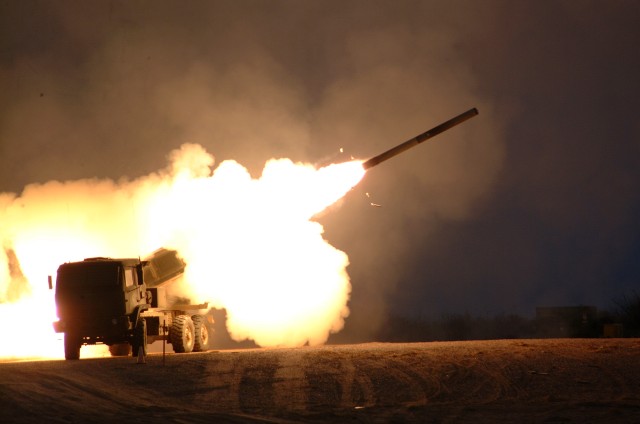REDSTONE ARSENAL, Ala. -- The High Mobility Artillery Rocket System is a repeat award winner.
This precision strike weapons system, assigned to fire brigades supporting brigade combat teams, is the only two-time recipient of the Secretary of Defense Performance-Based Logistics award. The award recognizes government and industry teams providing war fighters with exceptional operational capability through PBL agreements.
"This is the second time our team has been rewarded for a really good job of supplying fielded capabilities," said Col. David Rice, project manager for the Precision Fires Rocket and Missile Systems office of the Program Executive Office for Missiles and Space, which oversees management of the HIMARS program.
"From start to shoot, HIMARS is performing extremely well in a high-tempo environment and harsh conditions. Logistics is often an overlooked function. But this award shows that our HIMARS government-industry logistics team is a poster child for what performance-based logistics is supposed to look like."
The HIMARS Product Office, managed by Lt. Col. Greg Paul and including a team of about 150 employees, works with industry partner Lockheed Martin Missiles and Fires Control Systems of Dallas to provide logistics support for fielded HIMARS units. Also part of that partnership is the Aviation and Missile Command's Integrated Materiel Management Center and the Letterkenny Army Depot, Pa.
Currently, about 250 HIMARS units have been produced for the Army and Marine Corps with eight battalions fielded to the Army (four active and four National Guard) and two battalions to the Marine Corps (one active and one Reserve). The New Hampshire National Guard was the last unit to be fielded.
Since 2005, HIMARS has provided support in both Operation Iraqi Freedom and Operation Enduring Freedom, and is a key component in overseas contingency operations. Its six-pack system launches the Multiple Launch Rocket System family of rockets and missiles, and is designed to support Joint Early and Forced Entry Expeditionary Operations with high-volume destructive, suppressive and counter-battery fires.
"No launcher has ever refused a missile launch," Rice said. "The system is performing at above Army standards and Soldier expectations."
In-theater maintenance work is performed by Soldiers with the assistance of field service representatives. Lockheed Martin employees serve as the field reps, providing technical assistance and training to Soldiers who are HIMARS maintenance technicians. These Soldiers receive their initial training in the system's maintenance at the Ordnance Munitions and Electronics Maintenance School.
In addition, Lockheed Martin's supply chain management system is fully integrated with the standard Army system so that repair parts and other supplies can be quickly ordered and replaced.
"Our government-industry team is made up of consummate professionals who are experts at diagnosing any problems and then passing their expertise to Soldiers in the field so that they optimize HIMARS performance," Rice said.
The HIMARS PBL team first won the PBL award in 2005 and repeated in 2009. In 2008, HIMARS and Guided MLRS was the first Army system to be recognized with the William J. Perry Award, an annual award presented by the Precision Strike Association in recognition of achievements that result in significant contributions to the development, introduction and support of precision strike systems.
"People are beginning to sit up and take notice," Rice said. "Not only is this system performing well, but it's very highly dependable. It is an acquisition success story.
"Since its first fielding, the HIMARS system has provided our nation's war fighters with superior results. It's becoming increasingly important that our Army's systems remain engaged and viable to achieve our mission - and HIMARS is doing just that. This proven technology ensures that our Soldiers can stay in the fight, regardless of condition or circumstance. The accuracy, reliability and lethal technology that HIMARS provides in engaging long-range targets ultimately keep Soldiers from harm's way and saves their lives."
Once a system is fielded, it is the performance-based logistics team that assures ongoing performance. HIMARS has maintained more than 90 percent readiness.
"The key about PBL is it's all about partnering with private industry to improve weapon system readiness," said Mahona Carlton, who is the lead member of the PEO for Missiles and Space logistics team. "We are working to reduce costs by keeping the systems effective and efficient and reliable. We have been able to reduce ownership costs by 24 percent."
Because HIMARS is a PBL model system, its team provides DoD agencies with data from audit studies to show how to develop and manage a program used for sustainment systems.
"In 2003, we showed that we could be more efficient and effective by using PBL," Carlton said. "As a new start weapon system, at the system level we created a whole entity and a core capability at the Letterkenny Army Depot in support of PBL. Today, we modify and change PBL as our weapon system changes."
When establishing the government-industry team, Carlton said there were several U.S. government rules that had to be adhered to.
"You have to have a division of labor," she said. "We were able to empower everyone on the team with a hierarchy of controls in place. Dividing roles and responsibilities is key to partnering."
The partnering contract had to be written so that it remained flexible to the demands of the theater, said Floyd Lindsey, director of the Logistics Directorate for Precision Fires.
"The field service representative and the support in theater are in constant adjustment due to launchers being relocated and the changing fighting strategy and deployment," he said. "The contract had to be flexible to accommodate those adjustments."
As a responsive PBL program, the team remains vital and relevant to any challenges to the HIMARS readiness.
"Through metrics, the readiness is exceeded and reliability is more effective, and it's been that way on the battlefield from the first," Lindsey said. "Partnering - or teaming - has been important to this program from the beginning. We even developed the contract with our industry partner."
The HIMARS PBL team is one of the leanest within the Department of Army and the Department of Defense.
"Lockheed Martin is working in the visible areas with Soldiers," Carlton said. "They have done a wonderful job for us and really shine in what they do. They work really hard on this partnership and care for the Soldiers as much as we do."
The HIMARS PBL competed against more than 200 other systems within DoD for the PBL award.
"Our success has exceeded the DA goal," Lindsey said. "We've reduced costs, developed a strong partnership, increased reliability and developed core capabilities. Our common goal was to be a successful team that is innovative and flexible, and that has synergy."
Rice is in the unique position to have managed the MLRS Project Office earlier in his career, and then returned to PEO for Missiles and Space in his current position.
"We started working on the HIMARS concept in 1995-96 because we needed a fire support system that was deployable. MLRS had proven itself with Desert Storm. But we needed a multiple MLRS launch system that could be transported anywhere. HIMARS was it.
"It's nice to see this system come full circle. This is a system that delivers on rocket science. The innovative ideas of scientists and engineers at Redstone Arsenal started this system and have kept this project office viable."
Now, with a system that has shown its effectiveness in the field, attention has been shifted to logistics support that keeps the systems in top operating condition.
"HIMARS performance-based logistics is a collective effort between government and industry," Rice said. "This is a great example of how a life cycle management command construct should work. I am glad to see the spotlight shine on the logistics contribution to this system."




Social Sharing